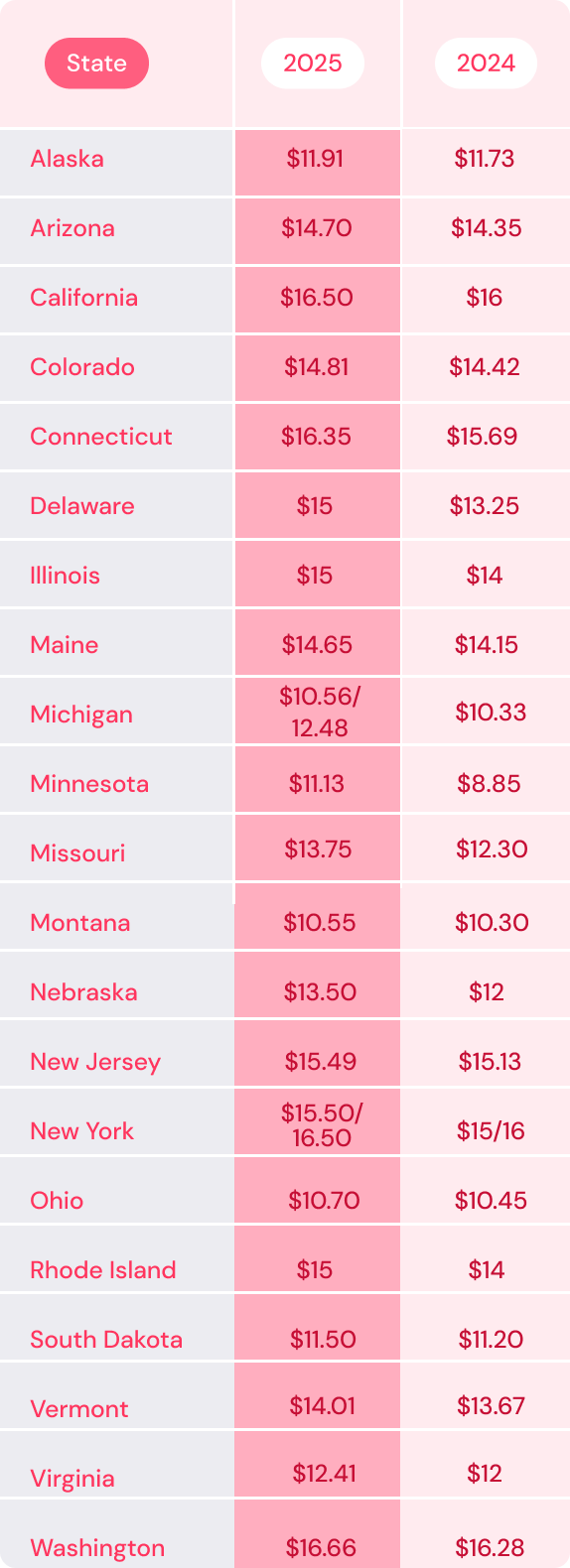Soaring inflation rates and stagnant federal minimum wage requirements have led many states to take action and make changes. In an effort to meet the rising Consumer Price Index, there will be a minimum wage increase for many states in 2025.
Whether you work in HR or are a small business owner, paying employees is surely one of the most critical (and stressful) responsibilities on your plate. After all, if your team isn’t paid correctly, you risk violating the Fair Labor Standards Act (FLSA), and you might even have to pay IRS penalties.
However, staying on top of yearly minimum wage increases and ensuring state and federal compliance can be overwhelming, to say the least.
In this article, we’ll go over some of the changes to plan for in 2025 so that you can make sure you stay up to speed while writing employee paychecks. Then, we’ll break down the latest minimum wage increases by state so that you can have a clear point of reference. Last but not least, we’ll discuss key steps that will help you to prepare for the upcoming changes.
Minimum wage overview
According to the International Labour Organization, “The purpose of minimum wages is to protect workers against unduly low pay.” Like other wage and labor laws, the minimum wage was created to minimize inequality and provide workers with fair earnings.
In the United States, different wage laws apply at the federal, state, and local levels. Currently, the federal minimum wage is set at $7.25 per hour. This amount was established by the U.S. Department of Labor (DOL) under the Fair Labor Standards Act (FLSA). Aside from minimum wage requirements, FLSA also details federal laws regarding overtime pay, recordkeeping, and youth labor standards.
Federal vs state vs local minimum wage
The federal minimum wage of $7.25 per hour was put into place in 2009 and has gone unchanged since. However, the majority of wage and hour laws across many states and local jurisdictions are different from the federal amount and change on a regular base. Here we’ll go through the specifics and point out some key differences between federal vs state vs local minimum wage.
Federal minimum wage
According to federal law, it is illegal for employers subject to FLSA to pay employees less than $7.25 per hour for untipped workers and $2.15 per hour for tipped workers, across the United States.
If an employer’s state minimum wage is higher than this amount, the employer must pay the higher of the two. For example, if an employee works in Florida, which has a state minimum wage of $13.00 per hour, you would disregard the Federal minimum wage and pay employees the determined state minimum.
If a state’s minimum wage is lower than the federal minimum wage, or if there is no set state minimum wage, it would only be legally acceptable to pay employees less than $7.25 if they are exempt from FLSA minimum wage laws. To find out which forms of labor are exempt from federal minimum wage and overtime laws, consult the U.S. Department of Labor website.
State minimum wage
Apart from federal wage jurisdiction, the majority of states have minimum wage and labor laws that employers need to abide by. There are many states whose minimum wages increase on an annual basis, and usually, the increments take place at the beginning (January 1st) or halfway (July 1st) through the year. This year, the minimum wage increase in 2025 will affect 21 states.
If your team is remote, you must pay employees based on the wages of their residence states, regardless of your business’s location.
Local minimum wage
Additionally, employers should keep in mind that local jurisdiction also varies within certain districts and municipalities. If an employee is working from a locality with an established “living wage” regulation that is higher than the state and federal minimum, you must pay them according to local jurisdiction, rather than the regulated state wage. The best way to ensure this is by checking local department of commerce websites. Pay differences by industry might also play a factor in established local minimum wages.
Perhaps you’d like to keep track of legal changes and deadlines in the coming year but don’t know where to get started. Keeping a HR compliance calendar will help you to plan ahead and stay on top of legal changes and make sure you don’t make any mistakes while managing your team’s operations.
Using a HR compliance calendar template, you can keep track of important dates and deadlines and make updates based on your team’s local and state laws. That way, keeping track of deadlines and staying on top of compliance in the coming year will be less daunting and more straightforward.
Minimum wage increases in 2025 and beyond
In 2025, a total of 21 states will see a minimum wage increase over the course of the year. As inflation and cost of living are making it difficult for residents of these states to afford their basic needs, some states have also stated from 2025 on they will begin adjusting their minimum wage according to
Over the years, there has been a steady minimum wage increase state by state. Some states, like Hawaii for example, have planned incremental growth. For example, the Hawaiian minimum wage increases by $2.00 per hour. In 2022, the minimum wage increased from $10.00 to $12.00 per hour. We saw another increase in 2024 from $12.00 to $14.00 per hour until they ultimately reach $18 per hour by 2028.
While the majority of the changes will take place on January 1st, 2025, there are a few that are planning to increase their minimum wages later on in the year. Here is an alphabetical outline of the 2025 increases in the minimum wage by state:
Increase minimum wage in 2025

Current minimum wage by state
Although 21 states will increase their minimum wages in 2025, there are 5 states that have not adopted a state minimum wage and use the federal rate as default. The other 29 states do not have any plans to increase their standard minimum wage in 2025. Here is an overview of minimum wage by state according to the U.S. Department of Labor.
The basic 2025 minimum wage for untipped workers
| State | Minimum hourly wage** |
| Alabama | No state minimum wage/$7.25 |
| Alaska | $11.91 |
| Arizona | $14.70 |
| Arkansas |
$11.00 for employers with more than 4 employees
$7.25 for employers with less than 4 employees |
| California | $16.50 *Not including specific county rates |
| Colorado | $14.81 |
| Connecticut | $16.35 |
| Delaware | $15.00 |
| Florida | $13.00 |
| Georgia |
$7.25 or
$5.15 for some limited FLSA situations |
| Hawaii | $14.00 |
| Idaho | $7.25 |
| Illinois | $15.00 |
| Indiana | $7.25 |
| Iowa | $7.25 |
| Kansas | $7.25 |
| Kentucky | $7.25 |
| Louisiana | $7.25 |
| Maine | $14.65 |
| Maryland | $15 *not including municipal minimum wage rates |
| Massachusetts | $15.00 |
| Michigan | $10.56 with another increase effective Feb. 21st, 2025 set to $12.48 |
| Minnesota | $11.13 |
| Missouri | $13.75 |
| Mississippi | $7.25 |
| Montana | $10.55 |
| North Carolina | $7.25 |
| North Dakota | $7.25 |
| Nebraska | $12 |
| New Hampshire | $7.25 |
| New Jersey | $15.49 |
| New Mexico | $12.00 |
| Nevada | $12 |
| New York | $15.50 state standard $16.50 for Long Island, Westchester, & NYC |
| Ohio | $10.70 |
| Oklahoma | $7.25 for businesses with more than 10 employees or more than $100,000 in gross annual sales |
| Oregon | $13.70 for non-urban counties $14.70 state standard $15.95 for Portland |
| Pennsylvania | $7.25 |
| Rhode Island | $15.00 |
| South Carolina | $7.25 |
| South Dakota | $11.50 |
| Tennessee | $7.25 |
| Texas | $7.25 |
| Utah | $7.25 |
| Virginia | $12.41 |
| Vermont | $14.01 |
| Washington | $16.66 state standard $20.76 for Seattle $20.17 for SeaTac |
| Wisconsin | $7.25 |
| West Virginia | $7.25 for employers with less than 6 employees $8.75 for employers with more than 6 employees |
| Wyoming | $7.25 |
| District of Columbia | $17.50 |
Basic minimum wage in major US territories
| Commonwealth of the Northern Mariana Islands | $7.25 |
| Puerto Rico | $10.50 |
| Virgin Islands | $10.50 |
| Guam | $9.25 |
**Minimum wage laws differ for tipped and untipped employees. You can find an up-to-date record of minimum wages for tipped and untipped employees here. Additionally, certain states contain addition wage tiers outside of tipped/untipped employees. For instance, New Jersey has a dedicated rate for agriculture workers. Please refer to each state’s guidelines for an in-depth understanding of how minimum wage increases can affect your business.
How employers can prepare
Ensuring that your team receives the right payment can be tricky, especially if you have remote employees scattered across the country. To finish off, we’ll go through a few HR tips to help you navigate payroll changes and policies for your team:
- If your company’s team extends across state lines, you have two options: (1) You can investigate and comply with minimum wage regulations within each state, or (2) You can find out which state has the highest minimum wage and opt to pay employees the higher rate across the board.
- Before paying your employees, it’s best to send out an official letter to notify employees about the upcoming salary changes set to take place and to verify their compliance with these changes.
- Paper payroll calculation can be a bit tricky to manage payment changes and ensure compliance, and it is much better to opt for payroll software to help you calculate salaries and budgets correctly. Using payroll software, you can ensure payslip accuracy, calculate overtime pay and deductions, and increase your overall fiscal compliance.
When looking for tools to help you with the minimum wage increase and employee payroll, you’ll quickly find that there are many different types of options available. The best and most straightforward way to stay compliant is to use an all-in-one payroll solution that can help you keep track of employee timesheets, time off, onboarding, and much more. If you’d like to learn more, give Factorial HR a try here.


